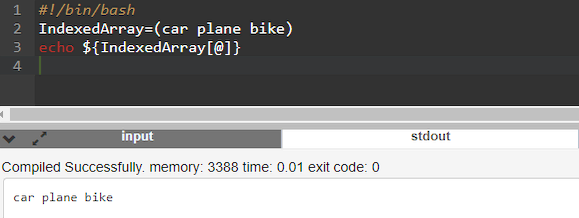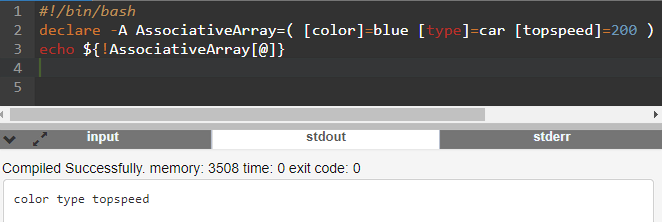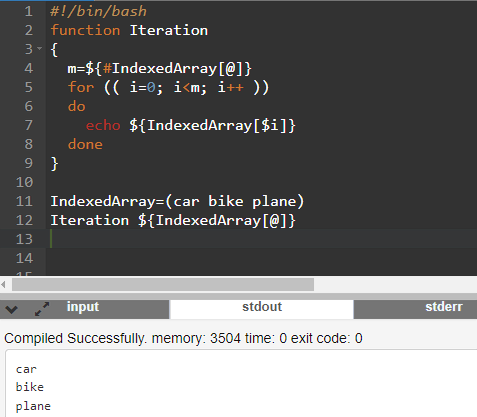07-22-2023, 05:12 AM
What Is a Bash Array?
A bash array is a data structure designed to store information in an indexed way. In other words, a bash array is a large group of variables. Unlike typical arrays used in other programming languages, bash arrays can store different types of elements. For example, you can use a bash array to store both strings and numbers.
There are two types of bash arrays:
- Indexed – the array is referred via integers or numbers.
- Associative – the array is referred via strings or a set of characters and words.
Remember that bash does not support multidimensional arrays, so it’s not possible to add an array within an array.
How to Declare Array in Bash
There are a few ways to declare indexed and associative arrays in bash. It’s worth noting that the bash array size does not need to be declared beforehand because bash arrays have no upper limit on the number of elements they can store.
Indexed Array
We will start with a simple bash indexed array. For example, we’ll use it to create a list of different means of transportation.
declare -a IndexedArray
IndexedArray[0]=car
IndexedArray[1]=plane
IndexedArray[2]=bike
The same can be achieved without the
declare builtin:
IndexedArray[0]=car
IndexedArray[1]=plane
IndexedArray[2]=bike
Or, make it even simpler by going with:
IndexedArray=(car plane bike)
Remember that indexing starts at 0, so the above example will assign the car element of the array to the 0 index.
However, there is an option to set an array with indices:
IndexedArray=([0]=’car’ [1]=’plane’ [2]=’bike’)
An interesting feature of bash arrays is that following index numbers in order is not necessary. For example, you can declare only the first and third elements while leaving the second element of an array empty:
IndexedArray[0]=car
IndexedArray[2]=bike
Associative Array
While indexed arrays don’t require the
declare builtin, it won’t be possible to create an associative bash array without declaring it first:
declare -A AssociativeArray
Next, add the values. Keep in mind that the key must be a string:
AssociativeArray[color]=blue
AssociativeArray[type]=car
AssociativeArray[topspeed]=200
An alternative way would be:
declare -A AssociativeArray=( [color]=blue [type]=car [topspeed]=200 )
How to Add a Variable to a Bash Array
Easily add bash variables using the
+= operator. For example, the process for an indexed array would look like this:
IndexedArray=(car plane bike)
IndexedArray+=(motorcycle)
The indexed array has a new element now. Remember that this method appends to the end of an array. Therefore, the motorcycle element will be added as the last element.
For associative arrays, the process is very similar. Except, you need to specify the keys along with all the elements:
declare -A AssociativeArray
AssociativeArray[color]=blue
AssociativeArray+=([tires]=alloy [engine]=gasoline)
How to Reference and Print an Array Element
Users can reference bash array values using the element index or key. To do this, create an indexed array:
IndexedArray=(car plane bike)
To reference the first array variable, use the following syntax:
${IndexedArray[0]}
Combine it with
echo, and you will get the following:
echo ${IndexedArray[0]}
The output will show you the first element. In this case, it’s car. The same logic applies when referencing and printing an associative array:
declare -A AssociativeArray=( [color]=blue [type]=car [topspeed]=200 )
echo ${AssociativeArray[type]}
The output will be car as well.
To print the whole array, use
@ as an index. The full script looks like this:
You can also print the keys of an array instead. To do this, add an exclamation mark before the array name:

How to Remove Bash Array Elements
Deleting array elements is similar to referencing them. Use an index or a key combined with the
unset builtin to delete an array element.Here’s an example of deleting a single element from an indexed array:

A similar logic applies to associative arrays:

To delete an entire array, specify
unset with the array name as shown here:
Nothing is shown after trying to print the array elements because the
unset builtin deleted them.How to Loop Through an Array
Creating bash loops is a fundamental aspect of learning bash scripting basics. You can use loops with arrays as well. For example, the most common use case is to iterate over each array item:

You can also combine keys with the array elements and print them all together like this:

How to Pass an Array to a Function
Functions save a considerable amount of time when scripting. Instead of writing the same code repeatedly, you can call out an already written function. We will combine the codeviously mentioned iteration loop and make a function out of it:
function Iteration
{
m=${#IndexedArray[@]}
for (( i=0; i
echo ${IndexedArray[$i]}
done
}
IndexedArray=(car bike plane)
Iteration ${IndexedArray[@]}
Running it on the command line will get you the following result:





